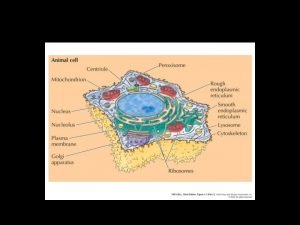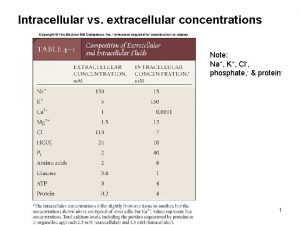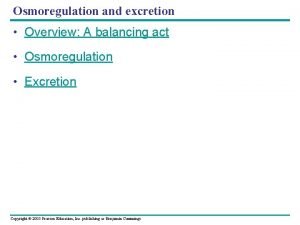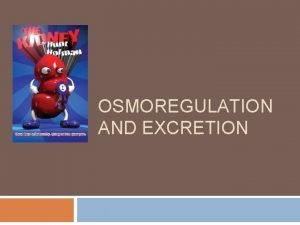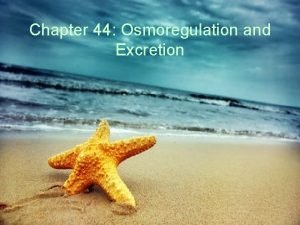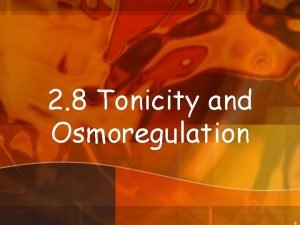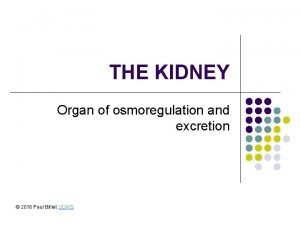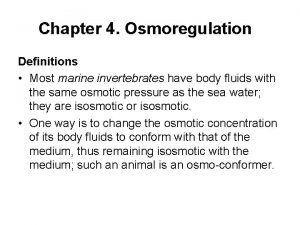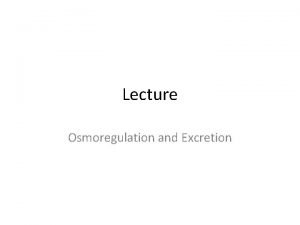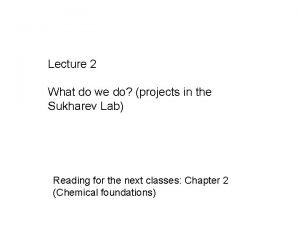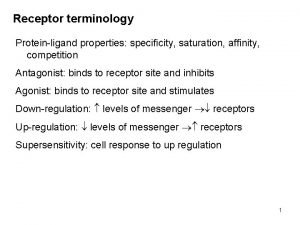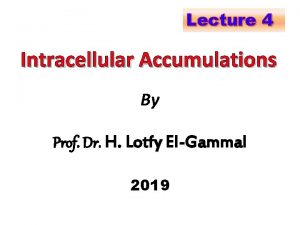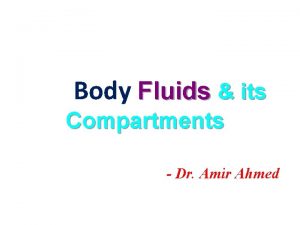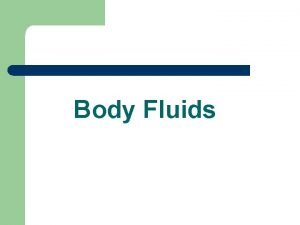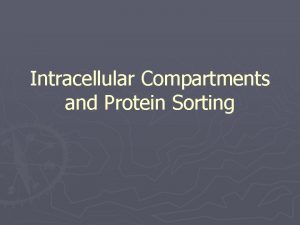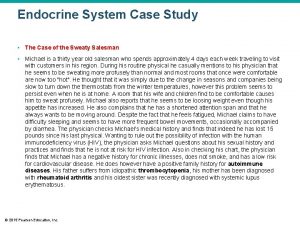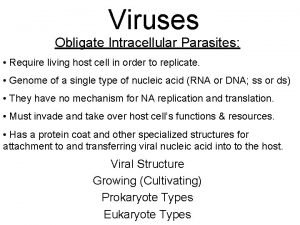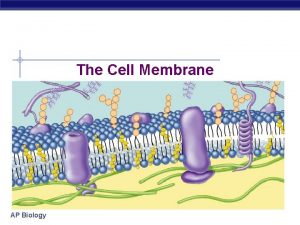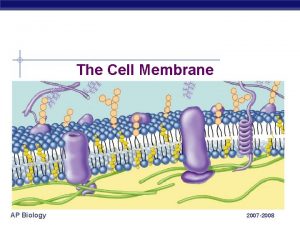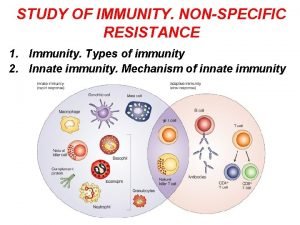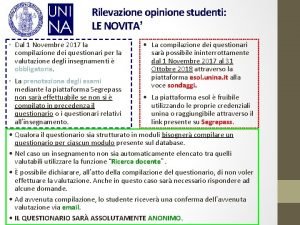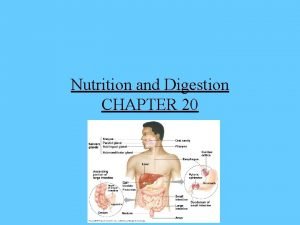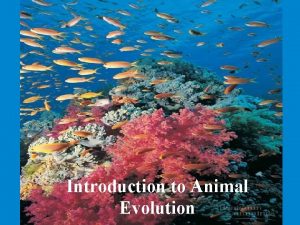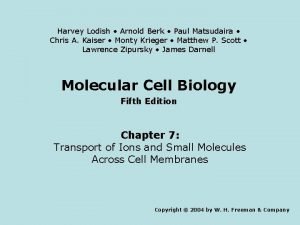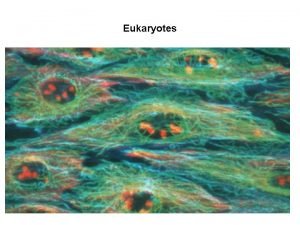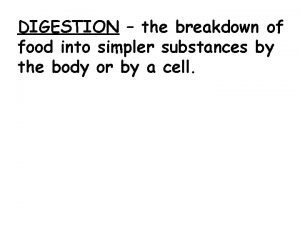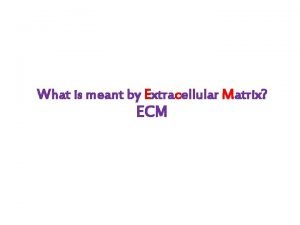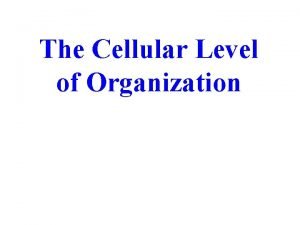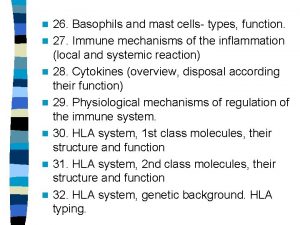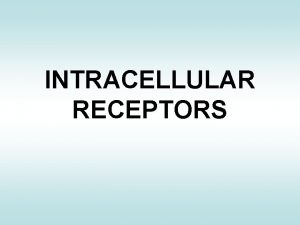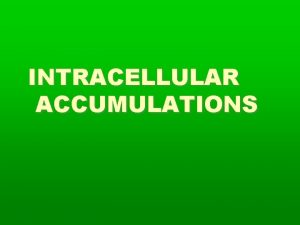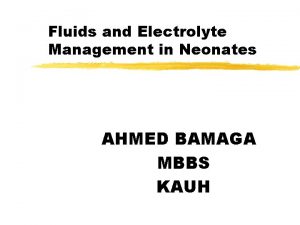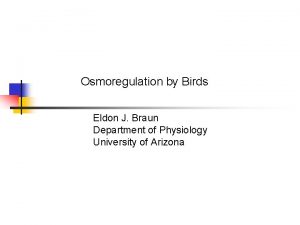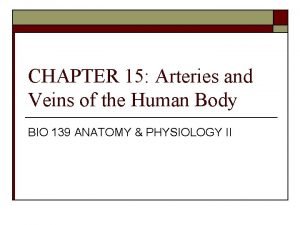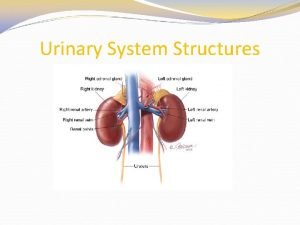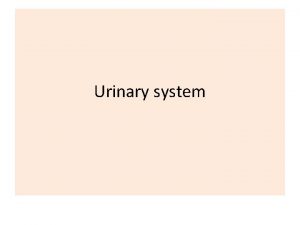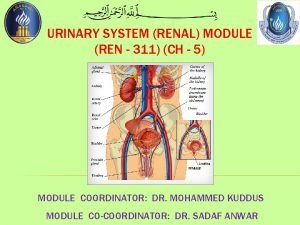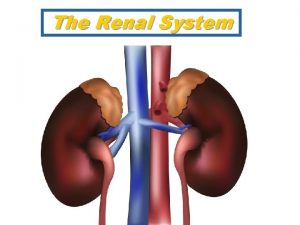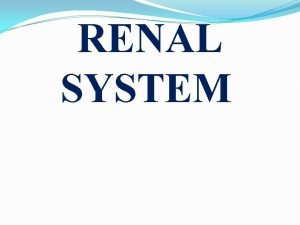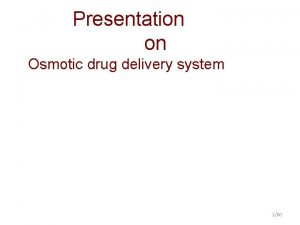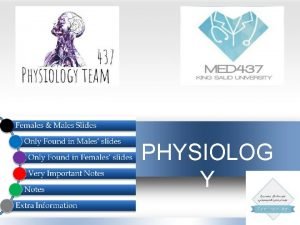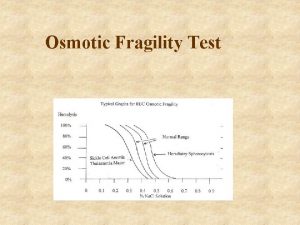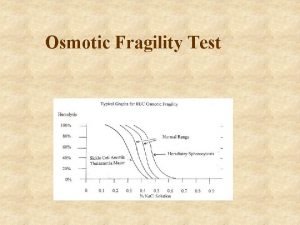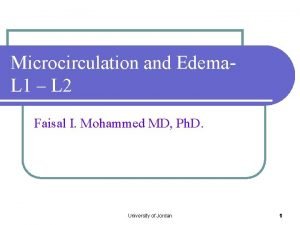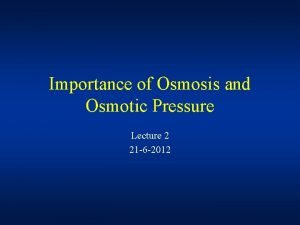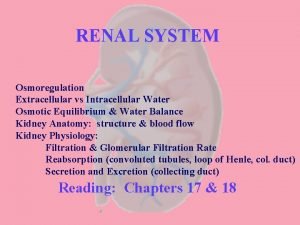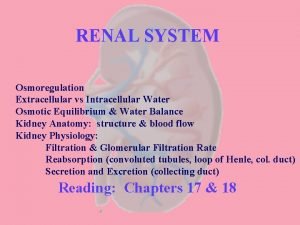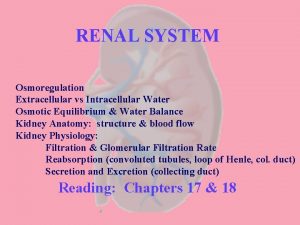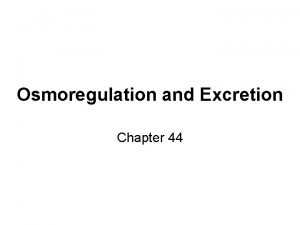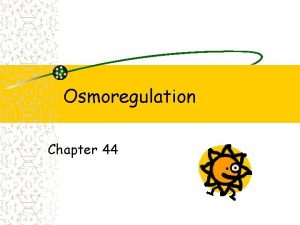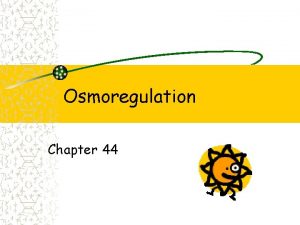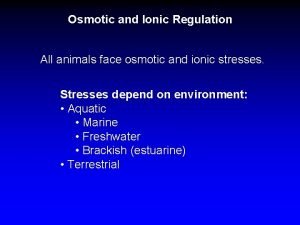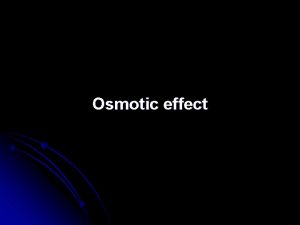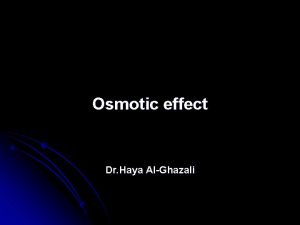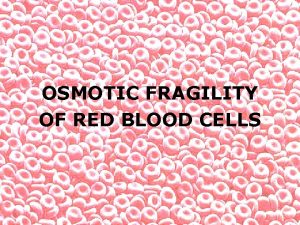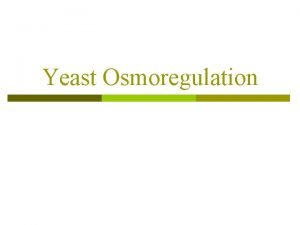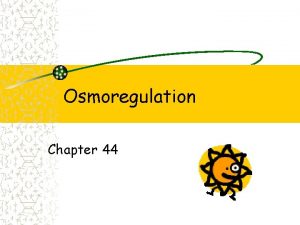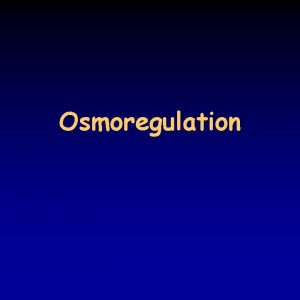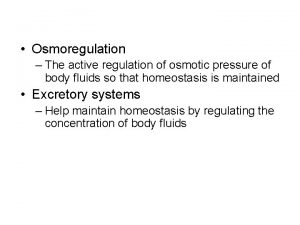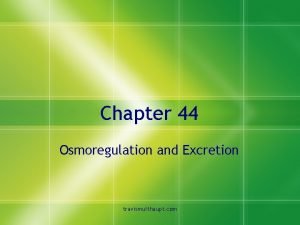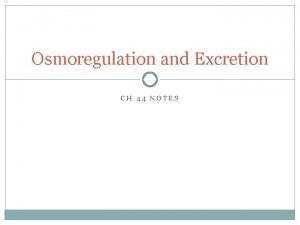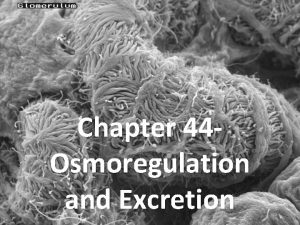RENAL SYSTEM Osmoregulation Extracellular vs Intracellular Water Osmotic















































![C. Erythropoietin *Monitors Oxygen Tension *Released by kidney as [O 2] in plasma drops C. Erythropoietin *Monitors Oxygen Tension *Released by kidney as [O 2] in plasma drops](https://slidetodoc.com/presentation_image_h2/10acedaff7fded0e2b8de63f12b66708/image-48.jpg)






















- Slides: 70

RENAL SYSTEM Osmoregulation Extracellular vs Intracellular Water Osmotic Equilibrium & Water Balance Kidney Anatomy: structure & blood flow Kidney Physiology: Filtration & Glomerular Filtration Rate Reabsorption (convoluted tubules, loop of Henle, col. duct) Secretion and Excretion (collecting duct) Reading: Chapters 17 & 18

Osmoregulation Maintaining osmotic balance (non-nutritional homeostasis)

Distribution of body fluids Intracellular Fluid = ICF fluid inside cell Extracellular Fluid = ECF fluid outside cell

Fluid Distribution in a 67 kg individual Water = 60% of body weight (0. 6) x 67 kg = 40 liters of water Water is divided into 2 compartments: ICF = 60% ECF = 40%

Fluid Distribution in a 67 kg individual ICF ECF 60% of body water 40% of body water 25 L (60% of 40 L) 15 L (40% of 40 L) Cytoplasm Plasma (3 L) Interstitial Fluid (12 L) More Proteins High in K+ High in Na + and Cl- Ions & nutrients Ions, nutrients, wastes 300 m. Osm ** Osmotic Equilibrium **

OSMOTIC EQUILIBRIUM When there is an equal distribution of ions and water on both sides of the cell membrane. The osmotic pressure is 300 m. Osm inside and outside of the cells. these cells are in an isotonic environment.

If there is sufficient Na+ ECF →cell Shrinks If there is too much K+ in the ICF →cell swells If there is too much water in ECF →cell swells

What is osmosis? Osmosis is the diffusion of water. What is diffusion? Movement of substances from an area of higher concentration to a lower concentration. Osmosis is the movement of water from a high concentration to a lower concentration

Non-nutritional homeostasis Involves: -ion concentration of body fluids -volume of body fluids -why is this important? There are many strategies for maintaining osmotic equilibrium

Mammals Balance Water Intake with Water Loss 850 ml (skin & lungs) 150 ml (feces) 1500 ml (urine) 2500 ml (total) Water Intake 750 ml (moist foods) 1500 ml (liquids) 250 ml (metabolism) 2500 ml (total)

Sites of Regulation 1. THIRST: -variable sensitivity in humans 2. Osmoregulation in KIDNEYS (urine production) -principle regulation of water loss -wide variety of consumption: *we get 400 to 2500 ml of water/day *we get 10 to 25 000 mg of Na. Cl/day BUT, Osmolarity of body fluids changes by <1% ! There is an obligatory water loss of ~400 ml (why? )

Mammalian Kidney Three Main Functions: 1. Remove wastes 2. Regulate fluid volume 3. Regulate ion concentrations 4. Are there any other functions?

Other functions of kidney 4. Secrete hormone erythropoietin to control RBC production 5. Role in the activation of vitamin D 6. Secretes hormone renin to help maintain BP.

Kidney Anatomy Location -lateral to vertebral column -by 11 th & 12 th ribs

Kidney Anatomy Landmarks: -Hilum = point of exit/entry for blood vessels & Ureters -Capsule = protective fibrous layer -Outer Layer = Cortex (granular) Bowman’s Capsules -Inner Layer = Medulla (striated) Renal Pyramids Loops of Henle & Collecting Ducts



Flow of Filtrate Collecting Duct Minor Calyx Major Calyx Renal Pelvis Ureter (peristalsis) Urinary Bladder Urethra

C. Urinary Bladder (function) -Stores Urine (200 -300 ml = ~ 1 cup) -Stretch receptors spinal cord internal sphincter relaxes (smooth) -External sphincter = skeletal muscle (relaxed when appropriate) -Epithelial type?

Urethra -Tube that carries urine out of the body -1. 5” in females, separate from reproductive system -8” in males, it has both urinary & reproductive functions Cystitis = inflammation of urethra & bladder 10 x more common in females? Why? Treatment?

Blood Supply Aorta Renal Artery Peripheral Branches (interlobar, arcuate, interlobular arteries) Afferent Arteriole (takes blood to glomerulus) Glomerulus (ball of capillaries) Efferent Arteriole (takes blood away) Peritubular capillaries (vasa recta) Peripheral Branches (interlobular, arcuate, interlobar veins) Renal Vein Inferior Vena Cava






D. Glomerulus -ball of leaky capillaries -afferent arteriole = large -efferent arteriole = small -high hydrostatic pressure inside the glomerulus -surrounded by Bowman’s capsule (= glomerular capsule) -1 million per kidney

Nephron -series of small tubes -surrounded by peritubular capillaries -1 million per kidney -functional unit of kidney -process blood into filtrate (urine)

Nephron -Bowman’s/glomerular capsule (funnel like opening) -proximal convoluted tubule (in cortex) -tubes straighten as they enter medulla -loop of Henle (descending and ascending limbs) -distal convoluted tubule (cortex) -collecting duct (medulla)



Three Primary Functions 1. Remove Cellular Wastes 2. Regulate Body Fluid Volume 3. Regulate Ion Concentration

These 3 tasks are achieved because the kidney is capable of: Filtration: substance moves from blood to the glomerular filtrate Reabsorption: substance moves from filtrate back to blood Secretion: substance moves from blood to the filtrate (urine) Excretion: elimination of a waste product from body

Filtering Plasma Fluid is pushed OUT of plasma in glomerulus into Bowman’s Capsule -High hydrostatic pressure at glomerulus: Why? The efferent artery is small, relative to afferent artery FILTRATE =water, ions, glucose, a. a. ’s, hormones, vitamin C, waste but, NO CELLS!

Glomerular Filtration Rate -volume of filtrate made by both kidneys = 115 ml/min (women) 125 ml/min (men) -about 7. 5 L of filtrate made every hour or 180 L/day (45 gallons!) REMEMBER: -180 L of filtrate made every day -1. 5 L of urine lost every day -most of the filtrate is reabsorbed

Tubular Reabsorption (PCT + loop of Henle + DCT) Proximal Convoluted Tubule (PCT) -located mainly in cortex -microvilli what does this tell you about function? -most of the filtrate is reabsorbed here (~87%) -volume of filtrate is reduced but it’s isosmotic w/ plasma (300 m. Osm) -active transport of Na+ from filtrate back to blood -water & Cl- follow passively -glucose moves to capillaries by facilitated diffusion & active transport -NO hormonal control here

Tubular Reabsorption (PCT + loop of Henle + DCT) Loop of Henle (2 main functions) 1. If excess water is consumed = 2. If there is dehydration = -lots of dilute urine made -helps decrease body fluid volume -sml. amount of concentrated urine made -help increase body fluid volume

Tubular Reabsorption (PCT + loop of Henle + DCT) Descending limb of the loop -permeable to water -impermeable to salt (probably) -interstitial space = very salty (due to activity of ascending limb) -water moves out -filtrate gets more concentrated -bottom of loop = filtrate 1200 m. Osm (hypertonic relative to plasma)

Tubular Reabsorption (PCT + loop of Henle + DCT) Ascending limb of the loop -permeable to salt -impermeable to water -Na. Cl diffuses OUT -Na is actively transported OUT -Cl follows passively -filtrates becomes more dilute -interstitial space get very salty -top of loop = filtrate 100 m. Osm (hypotonic relative to plasma)

Tubular Reabsorption (PCT + loop of Henle + DCT) Distal Convoluted Tubule (DCT) -reabsorption of any remaining nutrients -sensitive to ALDOSTERONE -Adrenal Cortex senses Na+/K+: -if low Na+ aldosterone Na+ reabsorbed -if high K+ aldosterone K+ secreted

Regulation of Body Fluid Volume (Collecting Duct along with loop of Henle) Collecting Duct -hypotonic filtrate enters collecting duct (CD) -CD is impermeable to water unless ADH is present -ADH increases the permeability of the CD to water

Overhydration Collecting Duct Impermeable (water stays in CD) Hypotonic Filtrate Excreted Reduction of Body Fluid Volume

Dehydration Hypothalamus Senses Reduction in Fluid Volume (osmoreceptors) ADH released from posterior pituitary Collecting Duct More Permeable Water moves OUT of CD passively (gradient formed by loop of Henle) Hypertonic Filtrate Excreted

Three Primary Functions 1. Remove Cellular Wastes -by filtration in glomerulus & by excretion in calyx & beyond 2. Regulate Body Fluid Volume -by reabsorption in loop of henle (Na. Cl gradient) & CD (ADH) 3. Regulate Ion Concentration -by secretion and reabsorption in DCT (aldosterone)

Urinary System (part II) Other Functions of the Urinary System: Focusing on Acid Base Balance Reading: Chapters 17 & 18

Renal Control of Blood Pressure Juxtaglomerular Apparatus = macula densa (cells of DCT) + afferent arteriole

A. Low Blood Pressure Juxtaglomerular Apparatus Renin-Angiotensin system Vasoconstriction (Na+ reabsorb/ K+secrete) B. High Blood Pressure/High blood volume Inhibits renin secretion Inhibits ADH production Systemic vasodilation Atriopeptin (Atrial Natruiretic Hormone) -produced by heart in response to stretch -Excretion of more salt and water-diuretic -Inhibits aldosterone activity
![C Erythropoietin Monitors Oxygen Tension Released by kidney as O 2 in plasma drops C. Erythropoietin *Monitors Oxygen Tension *Released by kidney as [O 2] in plasma drops](https://slidetodoc.com/presentation_image_h2/10acedaff7fded0e2b8de63f12b66708/image-48.jpg)
C. Erythropoietin *Monitors Oxygen Tension *Released by kidney as [O 2] in plasma drops *Acts on _________, stimulating _______ production

Regulation of p. H Normal Blood p. H = 7. 35 -7. 45 Maintained by chemical buffers AND physiological buffer systems

Where does H + come from? 1. Aerobic Respiration of Glucose C 6 H 12 O 6 + 6 O 2 6 CO 2 + 6 H 2 O + energy CO 2 +H 2 O --> H+ + HCO 3 -

Where does H + come from? 2. Anaerobic Respiration of Glucose C 6 H 12 O 6 + O 2 energy + lactic acid (H+ )

Where does H + come from? 3. Oxidation of sulfur containing a. a. H 2 SO 4 2 - + 2 H+ Despite these 3 sites of acid (H+) production… blood p. H is close to neutral (7. 35 -7. 45)

1. 2. 3. Blood p. H = 7. 35 -7. 45

Regulation of blood p. H CHEMICAL BUFFERS = 1 st line of defense ACID: Dissociates to release 1 or more H + when in H O 2 BASE: Accepts H+ when in H 2 O



Three Chemical Buffer Systems 1. Protein Buffer Systems: 2 HN --- aa --- COOH 3 HN amino group acts like base when p. H is too low COOcarboxyl group acts like acid when p. H is too high e. g. Hb (most of the H+ yielded in CO transport is carried by Hb) 2

Three Chemical Buffer Systems 2. Carbonic Acid Bicarbonate Buffer System: Bicarbonate (HCO 3 -) can act a weak base (pick up H+) Carbonic Acid (H 2 CO 3) can act as a weak acid (release H+) H+ + HCO 3 - --> H 2 CO 3

Three Chemical Buffer Systems 3. Phosphate Buffer System: PO 44 - ions = a major intracellular ion H 2 PO 4 - H+ + HPO 42 Dihydrogen P = weak acid, can buffer strong bases HPO 42 - + H+ H 2 PO 4 Monohydrogen P = -weak base, can buffer strong acid -also in urine to buffer acids

Chemical buffers try to keep p. H between 7. 34 and 7. 45…but under extreme conditions the chemical buffers can’t keep up!

What happens if p. H gets out of range? ACIDOSIS (<7. 35) -depression of CNS by inhibiting synaptic transmission -if less than 7. 0 low nerve function disorientation, coma, death

What happens if p. H gets out of range? ALKALOSIS (>7. 45) -over-excitability of CNS & PNS -nerves send impulses repetitively, even w/out normal stimulus -nervousness, muscle spasms, convulsions, death 1. p. H also affects enzyme function 2. We can only live ~ 1 min at p. H extremes So, p. H is closely monitored!

Regulation of blood p. H PHYSIOLOGICAL BUFFERS = 2 nd line of defense These buffer systems work when p. H changes lead to alkalosis or acidosis

Physiological Buffer Systems *Metabolic Imbalance Respiratory Compensation Exhale CO 2 Begins within minutes Finished within 2 hours *Respiratory Imbalance Metabolic Compensation Mainly in kidney Secretion of H+ Reabsorption of HCO 3 Begins within minutes Takes days to finish

H 2 O + CO 2 H 2 CO 3 H+ + HCO 3 -

ACIDOSIS & ALKALOSIS (causes & compensations) Respiratory Acidosis = Increased p. CO 2 LOW p. H Cause = -hypoventilation -emphysema, COPD, pulmonary edema, trauma to respiratory center, airway obstruction, … Compensation = metabolic (kidney) inc. secretion of H+ (PCT) inc. reabsorption of HCO 3 - (PCT, DCT, CD) H 2 O + CO 2 <--> H 2 CO 3 <--> H+ + HCO 3 -

ACIDOSIS & ALKALOSIS (causes & compensations) Respiratory Alkalosis = Decreased p. CO 2, ↑ p. H Cause = hyperventilation O 2 deficit, altitude, anxiety, pulmonary disease Compensation = metabolic reduced secretion of H+ reduced reabsorption of HCO 3 what else could you do as a treatment? H 2 O + CO 2 <--> H 2 CO 3 <--> H+ + HCO 3 -

ACIDOSIS & ALKALOSIS (causes & compensations) Metabolic Acidosis = ↓ bicarbonate, ↓ p. H Cause = -Loss of HCO 3 -Due to diarrhea with lower GI losses, -Due to kidney dysfunction Compensation = Respiratory Hyperventilation to blow off CO 2 H 2 O + CO 2 <--> H 2 CO 3 <--> H+ + HCO 3 -

ACIDOSIS & ALKALOSIS (causes & compensations) Metabolic Alkalosis = ↑ bicarbonate, ↑ p. H Cause = Loss of acid (vomiting, gastric suctioning) Excessive intake of alkaline drugs Compensation = Respiratory Hypoventilation, slows CO 2 loss H 2 O + CO 2 <--> H 2 CO 3 <--> H+ + HCO 3 -

END
 Ira pré renal renal e pós renal
Ira pré renal renal e pós renal Diagnostico etiologico
Diagnostico etiologico Bioimpedância
Bioimpedância Intracellular and extracellular
Intracellular and extracellular Transcellular fluid compartment
Transcellular fluid compartment Cl intracellular concentration
Cl intracellular concentration Peritubular capillaries and vasa recta difference
Peritubular capillaries and vasa recta difference Water and water and water water
Water and water and water water Osmoregulation
Osmoregulation Metanephridia and protonephridia
Metanephridia and protonephridia Types of excretion
Types of excretion Tonicity and osmoregulation
Tonicity and osmoregulation Renal artery branches
Renal artery branches Osmoregulation in invertebrates
Osmoregulation in invertebrates Protonephridia
Protonephridia Osmoregulation
Osmoregulation Homeostasis and evolution
Homeostasis and evolution Flaccid cell
Flaccid cell Flaccid cell
Flaccid cell Water potential equation
Water potential equation Osmotic potential vs water potential
Osmotic potential vs water potential Synovial membrane
Synovial membrane Intracellular receptors
Intracellular receptors Intracellular accumulation meaning
Intracellular accumulation meaning Interstitial vs intracellular
Interstitial vs intracellular Elastic tissue location and function
Elastic tissue location and function Intracellular accumulation
Intracellular accumulation Ecf icf and interstitial fluid
Ecf icf and interstitial fluid Body fluids
Body fluids Intracellular compartments and protein sorting
Intracellular compartments and protein sorting Intracellular hormone binding
Intracellular hormone binding Movement of body fluids
Movement of body fluids Virus types
Virus types Extracellular fluid
Extracellular fluid Extracellular fluid composition
Extracellular fluid composition Neutrophil extracellular traps
Neutrophil extracellular traps Apa fungsi membran sel
Apa fungsi membran sel Esol unina
Esol unina Youtube.com
Youtube.com Extracellular digestion
Extracellular digestion Extracellular digestion
Extracellular digestion Intracellular ph regulation
Intracellular ph regulation Outline two roles of extracellular components
Outline two roles of extracellular components Paramecium digestion process
Paramecium digestion process Extracellular signal
Extracellular signal Ecf in anatomy
Ecf in anatomy Activator protein
Activator protein Intracellular structure
Intracellular structure Neurotrasmiters
Neurotrasmiters Dry vs wet gangrene
Dry vs wet gangrene Intracellular receptors
Intracellular receptors Intracellular accumulations
Intracellular accumulations Major intra and extracellular electrolytes
Major intra and extracellular electrolytes Renal portal system
Renal portal system Renal portal system
Renal portal system Figure 15-4 is a diagram of a nephron
Figure 15-4 is a diagram of a nephron The urinary system is also known as
The urinary system is also known as Renal system
Renal system Diaphragm and kidney
Diaphragm and kidney Renal system
Renal system Osmotic demyelination syndrome risk factors
Osmotic demyelination syndrome risk factors Osmotic communication in agile
Osmotic communication in agile Rose nelson osmotic pump
Rose nelson osmotic pump Describe osmotic fragility test
Describe osmotic fragility test Starling forces equation
Starling forces equation Osmotic fragility test tube color
Osmotic fragility test tube color Osmotic fragility test شرح
Osmotic fragility test شرح Decreased osmotic fragility
Decreased osmotic fragility Oncotic pressure in capillaries
Oncotic pressure in capillaries Oncotic pressure
Oncotic pressure Oncoric pressure
Oncoric pressure



